Star Trek Over Detroit: Raiding the Legowelt archives
Later this month Créme Organization will release Crystal Cult 2080, the latest album of a long, triumphant, largely amusing and occasionally bemusing recording career for Danny ‘Legowelt’ Wolfers. As the site has interviewed Wolfers on several occasions, as well as making him one of the first contributors to our podcast series, we decided to turn the tables and treat this as opportunity to indulge in the cult of Legowelt and write about some of our personal favourites from the rich, varied and intimidating discography of Danny Wolfers. Read on as Richard Brophy, Alex Egan, Scott Wilson and Tony Poland write about their favourite curios, rarities, classics, imaginary soundtracks, Lowlands box jams and cover versions of proto-house classics.
Legowelt – Klaus Kinski EP (Bunker 2002)
The early ’00s must have been confusing for Wolfers. On one hand, he was playing big rooms and festivals thanks to Disco Rout – although as he pointed out to Juno Plus, this was shortlived when he and other Bunker freaks succeeded in clearing the floor – but on the other hand, his productions from this time bear the hallmarks of a producer only just finding his feet. In places, the arrangement is basic and the quality of the pressing is questionable to say the least – eight tracks on a single Bunker 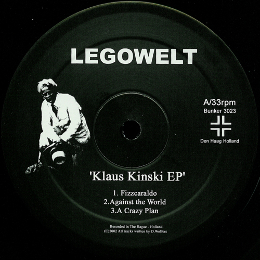 vinyl was never a guarantee of audio clarity – but these characteristics give Klaus Kinski, and many of the other projects from that period, like Gladio and Squadra Blanco an endearing, naive charm. The other great thing about Kinski is that it sees Wolfers lay bare his influences – the swirling, murky synths of “Arrival At The Station” has echoes of Suburban Knight’s spooky Nocturbulous Behaviour, while “Cherri Meets The Professor”, “Behind The Forest” and “Cherri’s Theme” are atmospheric sound scapes, punctuated by murky bass licks and the occasional drum crashing in.
vinyl was never a guarantee of audio clarity – but these characteristics give Klaus Kinski, and many of the other projects from that period, like Gladio and Squadra Blanco an endearing, naive charm. The other great thing about Kinski is that it sees Wolfers lay bare his influences – the swirling, murky synths of “Arrival At The Station” has echoes of Suburban Knight’s spooky Nocturbulous Behaviour, while “Cherri Meets The Professor”, “Behind The Forest” and “Cherri’s Theme” are atmospheric sound scapes, punctuated by murky bass licks and the occasional drum crashing in.
The most impressive contributions to Klaus Kinski however are “Fizzcaraldo”, “Against The World” and “Nomios – The Nomium Syndrome”. Of those three tracks, “World” sees the Dutch producer marry dramatic, melodic flourishes with electro 808s, while the other two pieces provide the blueprint for the subsequent Italo revival. “Nomios” is the more traditional of the two, with its acid-tinged, pulsing groove housing a typically ’80s-style tear-jerking hook. However, it’s “Fizzcaraldo” that really maps out the basis for Disco Rout and much of the Hague’s sound for the next decade as Wolfers combines steely, Chicago beats and a pulsing bass with a ghostly, dreamy synth segue that recalls the wide-eyed embrace of a sweat-soaked raver on an E honeymoon. RB
Polarius – Journey To A Land (Crème Organization 2002)
Polarius Man dons his snowshoes and goes straight in with the pounding kicks on this one. We all love a bit of sinister Legowelt vocal action (obviously) and alongside the disturbing voices that pepper the unparalleled “Night Of The Illuminati” or the tongue-in-cheek shit-stirring of “Gotta Have The Pokey”, “Ride The Mace” nails his signature creepy mutterings. Add a super-sleazy synth melody then repeat. A proper fist-pumper. The real gem on this 12″ though is “Apollo Park”. Even if Wolfers seems to have distanced himself from this sort of sound over the past few years, it must be one of the highlights from his vast output and up there with the catchiest. It’s another deceptively simple track with shimmering melancholic pads and an infectious bassline smothered in a blizzard of tape hiss. Perfect for precarious cable-car journeys and snow-mobile excursions.
On the flip, “Journey To A Land” and “At The Airport” roughly continue the same sonic themes as the A-sides – upfront drums and swirling melodies trudging through a thick mist of hiss – but in the more layered style we might associate with recent Legowelt productions. It’s “Apollo Park” that sets this record apart really – as a project Polarius isn’t quite as sonically cohesive as some of Wolfers’ other alter-egos, such as the obviously “Roman Days”-influenced Gladio – but as a whole, the Journey To A Land 12″ is a relatively raw and early example of Legowelt beginning to carve out his own unique sound. AE
Squadra Blanco – Night of the Illuminati (Holosnthesis 2002)
Originally released over a decade ago, Squadra Blanco is another fascinating side project that has only yielded one release to date – the Illuminati double pack. As anyone who has read the occasional missive from him on the Legowelt website – the accompanying rant to introduce The Teac Life was especially memorable – or now follows his mid-90s style ‘e-zine’ will testify, Wolfers takes life and his music with a huge grain of salt. Illuminati is his ode to the horror soundtrack genre, but it’s clearly designed to accompany a splatter fest like Evil Dead 2 than a pyschological headfuck like The 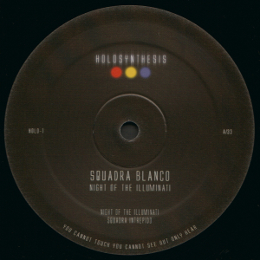 Shining. This is audible from the outset when the title track’s low-slung groove and pitched down vocal – Wolfers himself slowed down from 45rpm to 33rpm? – introduce the release. The sombre “Theme From The Forgotten Cable Car” is the kind of dirge best experienced behind the couch with the lights on and a kitchen knife in one hand, while “The Night Must Fall” features mesmerising synths to rival John Carpenter and a daft vocal telling the listener ‘don’t be afraid’.
Shining. This is audible from the outset when the title track’s low-slung groove and pitched down vocal – Wolfers himself slowed down from 45rpm to 33rpm? – introduce the release. The sombre “Theme From The Forgotten Cable Car” is the kind of dirge best experienced behind the couch with the lights on and a kitchen knife in one hand, while “The Night Must Fall” features mesmerising synths to rival John Carpenter and a daft vocal telling the listener ‘don’t be afraid’.
It’s hilariously camp stuff, but Illuminati isn’t just about exploding skulls or naked virgins getting drenched in gallons of blood. “We Are The Illuminati” and “Berg Hotel” are less threatening, almost fragile dawn chorus-style sound scapes and like the Klaus Kinski release, Illuminati also sees Wolfers lay down the basis for the electronic disco revival that still resonates. “The Dream That Doesn’t Stop” is a hypnotic, pulsing groove, featuring a series of epic hooks, while the brilliantly named “Purification The City Shall Burn Tonight” is all shimmering synths and liquid bass tones. It set the scene for the Dutch West Coast sound, but its chilling undercurrent. It also captures the early morning scene in the imaginary horror movie after our beleaguered hero spent the night hunting down the ghoul before decapitating it and throwing its remains onto a cliff-top pyre. RB
Gladio – Slave of Rome (Bunker 2003)
Danny Wolfers is a man of many aliases, but he has only put out two records under the Gladio pseudonym, the first of which went out in 2003 on Bunker. It’s funny to think that Slave surfaced shortly after Legowelt’s crossover release Disco Rout. While Rout achieved big room exposure thanks to Sven Vath’s patronage, Slave was a different matter entirely, suited to the grimy machinations of the back room. Rudimentary-sounding throughout and under-produced in places, it starts with the title track’s bacchanalian bass rumble and tight 808s before slipping into the suggestive vocal samples and melodic builds of “Gladio Will Survive”.
Despite being less polished and DJ friendly than his later work – Wolfers told Juno Plus in 2012 that his early work was not properly EQed for club usage – Slave of Rome, like Klaus Kinski has an undeniable, albeit basic charm. As the naïve synths and garbled voices on “The Slavemarket” show, it also set the scene for the Dutch producer’s tendency to squeeze the most tearjerkingly beautiful melodies from his equipment and to be utterly camp when required. All of these qualities come together on the release’s highlight, “Caligula”, with horror movie screeches and murky vocals competing with percussive volleys and an orgy of squelchy acid and eerie synths. It’s just what the emperor ordered. RB
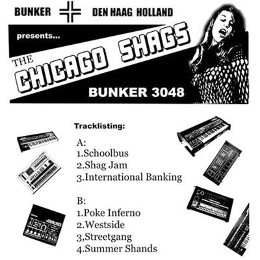 The Chicago Shags – Chicago Shags (Bunker 2005)
The Chicago Shags – Chicago Shags (Bunker 2005)
In addition to his vast archive of solo work, it’s difficult not to touch on some of the collaborative projects Danny Wolfers has been involved in over the years. We all know he’s currently enjoying working with Sheela ‘Xosar’ Rahman under various guises, but Wolfers has also previously worked with Bunker founder Guy Tavares, Traxx, William Burnett and ‘Orgue Electronique’ Schijf. Indeed the pair of Den Haag denizens have collaborated frequently over the years, with some of their best work together coming under the Chicago Shags name.
If you’re a fan of Legowelt, it’s probably because you invest in the story as much as the music, and their reasoning for choosing the Chicago Shags name is quite superb. Inspiration for the name comes from 1960s girl group The Shaggs, a trio of sisters who couldn’t play instruments or sing in tune formed at the behest of a father driven by a vision. The Shaggs were famously described as “sounding like lobotomized Trapp Family singers” by Rolling Stone magazine, and in honour of this musical ineptitude, Wolfers and Schijf named themselves The Chicago Shags, as their earliest material together was put together swiftly without any apparent effort. Having investigated the record in question – a self-titled slab for Bunker in 2005 – retrospectively, it’s my personal thought that Wolfers is either being modest or facetious in making such claims as it remains an all too potent example of dark acid-fuelled box jams. TP
Sammy Osmo – De Originale Filmmuziek Van Schaduw Horizon (Strange Life 2008)
What Wolfers truly excels at is creating whole worlds or scenarios within his music, titles and artwork that are ideal for letting your imagination wander. I can’t think of another producer still releasing techno/house 12″s on a regular basis who has also amassed such a large and varied discography of immersive, conceptual electronic music ‘on the side’. If that wasn’t enough, he dabbles in a number of collaborations with other artists, software programming, writing e-zines, releasing the occasional sample pack and directing videos, a wealth of which is thankfully conserved on his website. You can’t help but wonder where he finds the time.
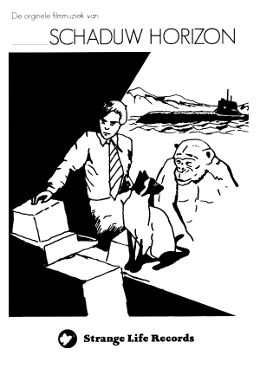 Wolfers’ sadly dormant Strange Life label released just over forty of these sonic adventures within six years and while a fair few are by guest artists, about twenty albums are Danny under at least a dozen aliases. Even when you take into account the depth of content and speed in which it was recorded, if you also consider how Wolfers created entire backstories – no doubt embodying multiple personalities while recording – then restricted himself to using specific synths for certain projects, the quality in these CDRs is jawdropping.
Wolfers’ sadly dormant Strange Life label released just over forty of these sonic adventures within six years and while a fair few are by guest artists, about twenty albums are Danny under at least a dozen aliases. Even when you take into account the depth of content and speed in which it was recorded, if you also consider how Wolfers created entire backstories – no doubt embodying multiple personalities while recording – then restricted himself to using specific synths for certain projects, the quality in these CDRs is jawdropping.
I could pick any number of these albums, as personally, Danny’s Strange Life output is still my favourite area of his work. For its sheer attention to detail though, I’m going for the Shadow Horizon film soundtrack, the accompaniment to a supernatural cold war thriller that follows the exploits of a military physicist, his psychic cat and chess-playing monkey (naturally), from abandoned zoo to mystery island. The package is superb; you’re provided with an in-depth description of the circumstances surrounding each track, a secret code document to decipher and unlock “the secret”, a map of the zoo and a Shadow Horizon sticker. The music itself is exceptional; a suite of grade-A atmospheric paranoia crafted entirely on the legendary Yamaha DX7IID. The only downside is that the film doesn’t actually exist. AE
Satomi Taniyama – Portopia (Strange Life Records 2010)
If Wolfers’ Discogs page is to be believed then Satomi Taniyama is another one of his many aliases, but even if not, for the purposes of this list, it hardly seems to matter. The cast of characters assembled by Wolfers on his Strange Life label are as much a part of the mythology of Wolfers as his music, and Satomi Taniyama has one of the most alluring back stories of them all. If you are to believe Strange Life’s version of events, the Portopia CDr was assembled by cassette tapes sent to Wolfers by a Japanese garbage man from Oda in the Shimane Prefecture, containing music influenced by Portopia (one of Japan’s first and most famous text adventure games) created with “old broken instruments found in the line of his work”.
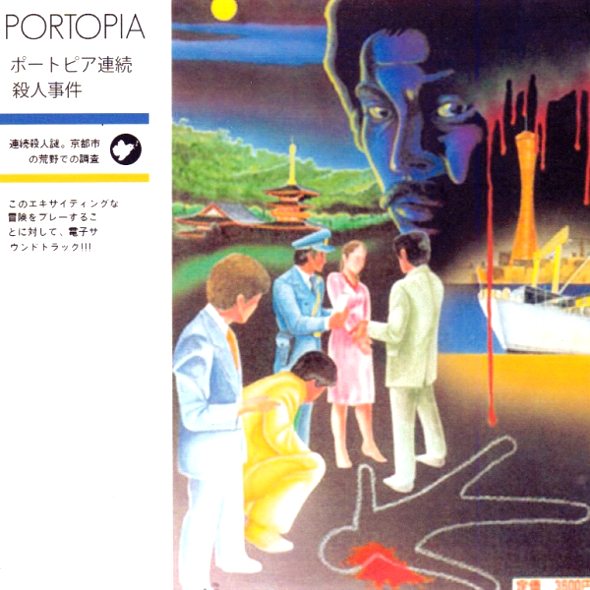
The clues are all there for being a Wolfers alias, but the music is something else entirely. Although the tape-saturated palette of vintage synths feels like it should be unmistakably that of Wolfers, the faintly Eastern melodies that run throughout and complete lack of beats are at odds with most other music he has made. The psychedelic chimes of opener “Window Fish” sound like they should be from a ‘60s exploitation film, while the scrambled waves and atonal keys of “Kyoto Blues” and library music vibe of “Century” are some of the most serene pieces of music released by Strange Life. Just as many of Wolfers’ more straight-up productions transport you to an imagined alternate Detroit, Portopia takes you to a parallel Japan, half rendered in pixels and half in tape echo. Whether the work of Wolfers or not, the fact that he helped to unleash this curiosity into the world is reason enough to hunt it down. SW
House Of Jezebel – Love & Happiness (Voyage Direct 2011)
First Choice’s take on “Love & Happiness” has remained a much sampled outlet for house music since the original master Ron Hardy first used and abused it for implementation at Chicago club The Music Box. Splicing elements of the female trio’s version with Al Green’s original, “Ron’s Luv N Happiness” has gone down in house music folklore and remains highly sought after. Whilst no one has quite managed to capture the mind bending qualities of Ron Hardy’s version, Danny Wolfers came close with his version that eventually appeared under the House Of Jezebel name on Tom Trago’s Voyage Direct label back in 2011.
“Love & Happiness” began life as a Smacko’s Rework of “Ron’s Luv N Happiness” posted on the unreleased stuff section of Wolfers’ own delightfully low budget website, an area that’s proved rich pickings for labels over the years. Signed by Voyage Direct and released under the House of Jezebel name, this is the sort of track that should be played to any number of current producers currently diluting the name of deep house as an exercise in demonstrating how to achieve true deepness. Focusing on the vocals of the First Choice version, the House Of Jezebel production ripples with sensuality and also successfully recreates the bassline from an unreleased Marshall Jefferson production that Hardy originally used. TP
Legowelt – Loch Ness Commodore 64 Soundtrack (free download 2013)
How many people out there knew that Danny Wolfers has his own software company? Granted, PACIFIC MICRO INTERNATIONAL is, by Wolfers’ own admission a “fly by night software company” with the sole product on his website a “dimensional occult transceiver”, but it’s clear that for Wolfers, computers like the Commodore 64 and the Amiga were the tools of his musical experimentation long before he owned his first analogue synthesiser. Although 2009’s Amiga Railroad Adventures album 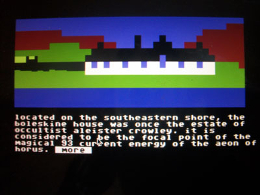 saw Wolfers release an entire album of tracks made with the Amiga 1200, and he created an entire text adventure for the C64 under his Franz Falckenhaus alias, this freely available oddity is perhaps the most interesting of his primitive computer-based compositions.
saw Wolfers release an entire album of tracks made with the Amiga 1200, and he created an entire text adventure for the C64 under his Franz Falckenhaus alias, this freely available oddity is perhaps the most interesting of his primitive computer-based compositions.
Composed for Loch Ness, a game created by the winner of a competition Wolfers ran at the beginning of 2013, its combination of thick bass drone and survival horror type melodies have all the unmistakable signature of Wolfers, but with an 8-bit crunch that goes far beyond the usual tropes of most chiptune efforts.Detroit techno may be the most obvious touchstone for people trying to understand Wolfers’ music, but his love of video games – especially primitive tape-based games – is just as important for understanding what makes him tick. SW
